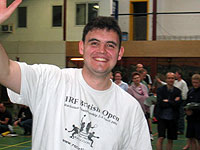
No more Class 1.
English racketlon personality Ray Jordan is referred to Class B (or possibly Class A??)
The End of the "Class 1" Era
Date: 2006-01-03
_________________
According to a new requirement in the IRF Requirement Specification for the 2006 World Tour the classes in each of the tournaments on the tour shall be named according to the following conventions:
Class A (Elite)
Class B (Advanced)
Class C (Amateur)
Class D (Beginner)
During earlier years the IRF have not required anything specific
regarding the naming of the classes although the conventions used
in Sweden traditionally have come to dominate, that is:
Elite/Open
Class 1
Amateur

No more Class 1.
English racketlon personality Ray Jordan is referred to Class B
(or possibly Class A??)
The reason for the change is to avoid confusion. In general, the IRF believe that the new conventions will come across more clearly on an international level. In many countries the letter "A" and the number "1" are clearly (and understandably) associated with the top level, whereas in e.g. Sweden and Finland it is, at least when it comes to sport, instead often linked to the topmost of the levels under the Elite class. The IRF have chosen the first of these two alternative interpretations since they believe it represents a more straightforward logic which should be understandable in all countries. That is why the "Class 1" name for the second class is now abandoned.
Note that the change is just a matter of naming and nothing
else. The new "Class A" will be identical to the old
"Elite Class" in all aspects but the name. And so is
the case for "Class B"/"Class 1" etc. The
Class D is not really a novelty either since several tournaments
have already had a fourth Beginner Class. (And it should be noted
that it is not a requirement that all four classes have to be
offered. Like before some tournaments will have several classes
on offer and others fewer (especially the Ladies' category and
the age categories - i.e. vets and juniors - will probably
continue to contain one single class in most tournaments.)
The change will be introduced starting immediately - although,
for practical reasons, both systems will, of course, exist in
parallel during a short transition period. (It is e.g. considered
too late for the upcoming Swedish Open to change since this
decision was taken quite recently.)
As regards the age classes there is no change. They will
mainly be U21 and 45+ as before, defined according to the
following excerpt from the Tour Requirement Spec:
The age classes shall be named and defined
in accordance with the following conventions:
"Juniors, under 21" or "U21", open to all
players that turn 21 during the season (calendar year), and
younger (i.e. it is enough for the condition "<21"
to be fulfilled at some point during season).
"Veterans, over 45" or "45+", open to all
players that turn 45 during the season (calendar year), and older
(i.e. it is enough for the condition ">45" to be
fulfilled at some point during season).
_________________________________